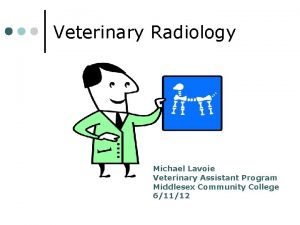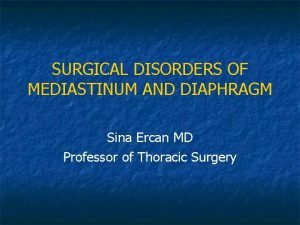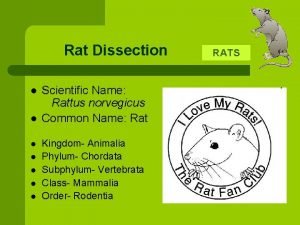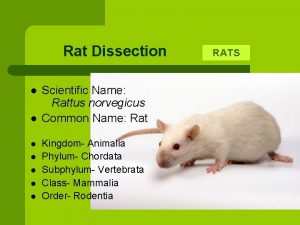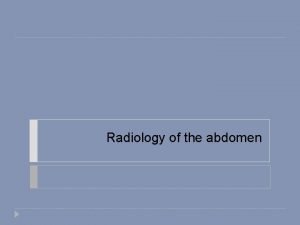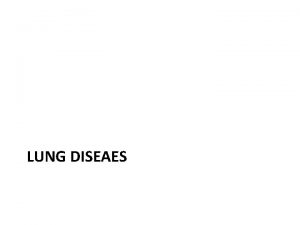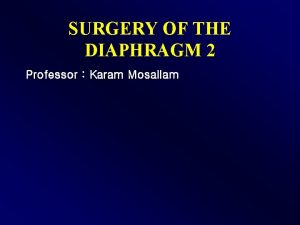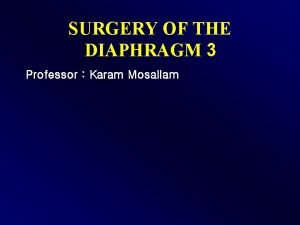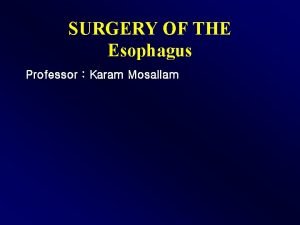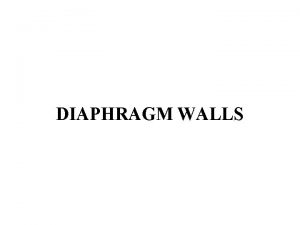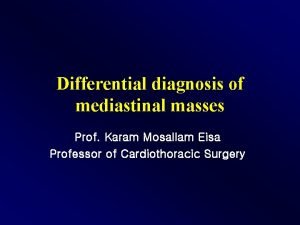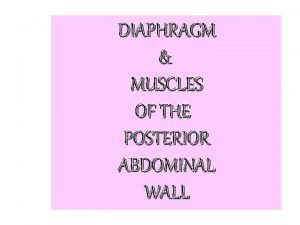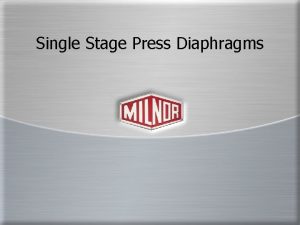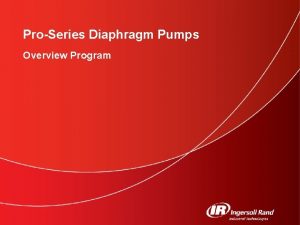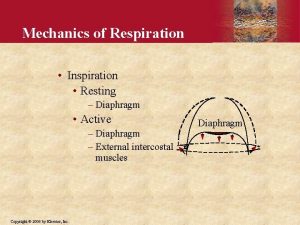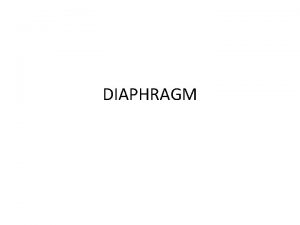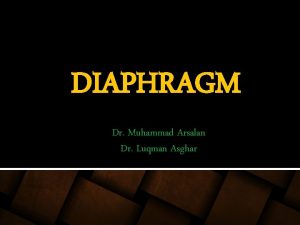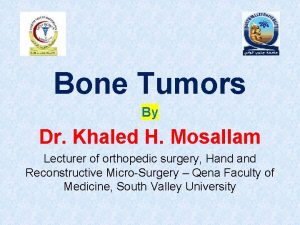SURGERY OF THE DIAPHRAGM Professor Karam Mosallam Introduction















- Slides: 15

SURGERY OF THE DIAPHRAGM Professor : Karam Mosallam

Introduction Anatomy of Diaphragm: -Fibromuscular. -Normal anatomical openings. - Blood sypply & Innervation.

Definition a A diaphragmatic hernia is defined as an abnormal communication between the abdominal and thoracic caviti with or without abdominal contents. b. A Diaphragmatic eventration is abnormal elevation of th diaphragm due to paralysis or weakness of muscles of the diaphragm.

Types&Etiology 1 -Congenital: * Morgagni(anterior or retrosternal). * Buchdalek(posteriolateral). 2 -Traumatic: *Accidental trauma. *Iatrogenic. . during surgery. 3 - Hiatus Hernia

Congenital Diaphragmatic Hernia • • • Epidemiology; 1/200 -1/5000 live births. M: F- 1: 2. Left side more common (85%). Usually associated with other anomalies. Usually sporadic may be familial.

Symptoms &Signs • • • Respiratory Distress. Scaphoid Abdomin. Increased Chest wall diameter. Bowel sounds heared in the chest. Decreased or absent breath sounds on side of hernia. • Contralateral shift of the heart and mediastinum.

Delayed presentation May be: Regurgitation, vomiting, intestinal obstruction Rarely shock and sepsis due to hernial incarcination.

DIAGNOSIS Prenatal ultrasound; can diagnose many cases. After delivery: Chest X ray may need insertion of nasogastric tube. Gatrografin or barium studies. CT&Echocardiography may be needed in some cases.

Prognosis Overall survival 67%. Intrauterine fetal death around 8%. Poor prognosis if symptoms appear at the first 24 hours. Severe pulmonary hyperplasia. Need for ECMO. . poor prognosis.

Prognostic imaging features • Lung to head ratio. . LHR. If LHR less than 1. . poor prognosis. If LHR 1 -4. . improved prognosis. • Liver in thorax. . poor prognosis.

Differential diagnosis • Diaphragmatic eventration. • Brochogenic cyst. • Cystic lung diseases: cystic adenoid malformation & Pulmonary sequestration. • Tumors ; Neurogenic&sarcoma

Treatment • Initial management: Aggressive respiratory care. Nasogastric tube &urinary catheter. • Ventilatory support may be needed in some patients; - Conventional mechanical ventilation. -ECMO (Extracorporeal membane oxygenation). • Nitric oxide inhalation(selective pulmonary vasodilator).

SURGERY Usually after 48 hours after stabilization of respiratory Distress and improvement of pulmonary hypertension. • Reduction of the content of hernia and closure of the defect either direct if a small defect or by use of a patch( native tissue or synthetic patch.

Surgical approach • Subcostal; most common. Rerely thoracotomy. • Laparoscopic • Thoracoscopic

Complications • • • GERD in 50% Recurrence. Intestinal obstruction. Delayed growth. Pectus excavatum. Scoliosis.
 Promotion from assistant to associate professor
Promotion from assistant to associate professor Sequential sampling ppt
Sequential sampling ppt Karam tuzlash texnologiyasi
Karam tuzlash texnologiyasi Karam tuzlash texnologiyasi
Karam tuzlash texnologiyasi Transverse cut of a banana
Transverse cut of a banana Rhinophyma austin
Rhinophyma austin Middlesex radiology
Middlesex radiology Denuding tower
Denuding tower Lethenic
Lethenic Rat digestive system diagram
Rat digestive system diagram Diaphragm of rat
Diaphragm of rat Rigler sign
Rigler sign A regulator diaphragm is often made from ____.
A regulator diaphragm is often made from ____. Diaphragm muscle origin and insertion
Diaphragm muscle origin and insertion Increased retrosternal space
Increased retrosternal space Rotating disc where the objectives are attached
Rotating disc where the objectives are attached






